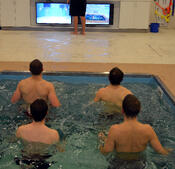
Hydrotherapy can reduce weight-bearing to 20%, enabling re-education of gait to commence very early in a patient’s recovery. Many patients are discharged from the hospital partially weight-bearing or are unable to fully weight-bear due to pain. Patients often adapt altered movement patterns when mobilizing that can subsequently be difficult to correct when fully weight-bearing.
The use of underwater cameras provides immediate feedback to the patient, allowing them to instantly alter their gait. This webinar will cover how to
identify dysfunction of walking and running gait on land. The presentation will detail exercises in the pool that may improve the altered movement patterns and the outcomes gained using aquatics with patients at Perform, St. George’s Park.
Attendees of this webinar will learn:
*Continuing Education (you must attend the live webinar in it's entirety):
Athletic Trainers: One CEU available for Athletic Trainers through BOC (Course ID: P3003-2000)
All Others: Certificates will be available if you wish to petition your certification agency for CEUs.
“The presenters did an excellent job of explaining the rationale for the exercises. This was an interesting look at how to develop speed both on land and in the water.”
- P.S. (webinar previously attended: "Use of Aquatics for Improving Linear Speed Mechanics", May 21,2013 presented by Lance Walker )
"Thank you for sharing this information. It is "value added" to the use of our HydroWorx pool!"
- J.M. (webinar previously attended: "Use of Aquatics for Improving Linear Speed Mechanics", May 21,2013 presented by Lance Walker )
Kerry Glendon graduated from Keele University in 2007 with a BSc Physiotherapy degree. She has since completed her Masters in Manual Therapy at the University of Nottingham and gained membership of the Musculoskeletal Association of Charted Physiotherapists (MACP). Kerry completed her Acupuncture foundation course in 2008 and has since used acupuncture in her practice. Kerry also works with the FA Ladies National Football squads during training, matches and international competitions across all age groups.
Kerry has a wealth of experience having worked for a rugby team and in a National Health Service setting for the past six years, gaining experience and expertise in Musculoskeletal Physiotherapy. She has a clinical interest in shoulder and spinal conditions which she has focused on during her Master’s dissertation.
Phone: 800.753.9633
Copyright © 2023 HydroWorx

